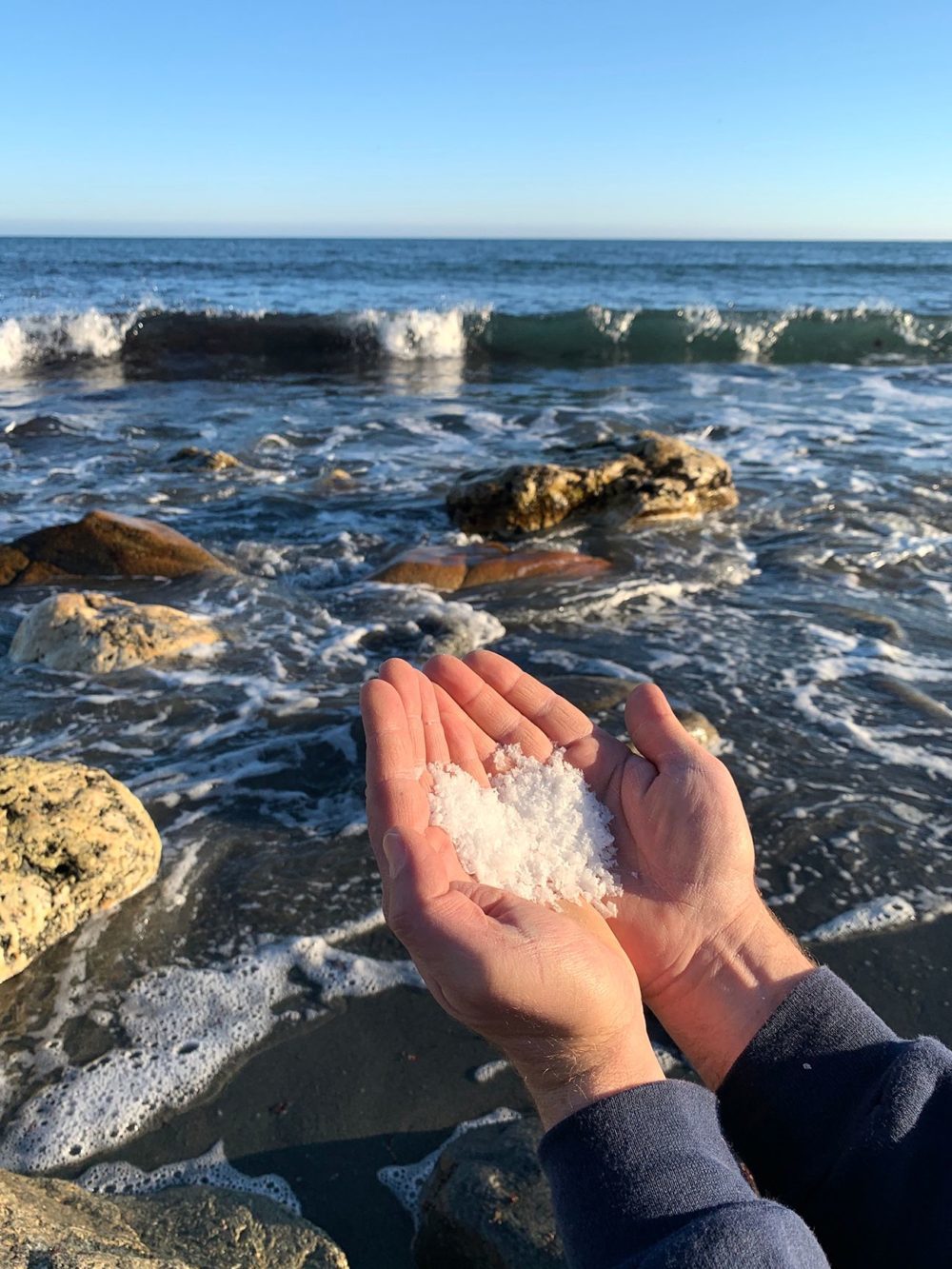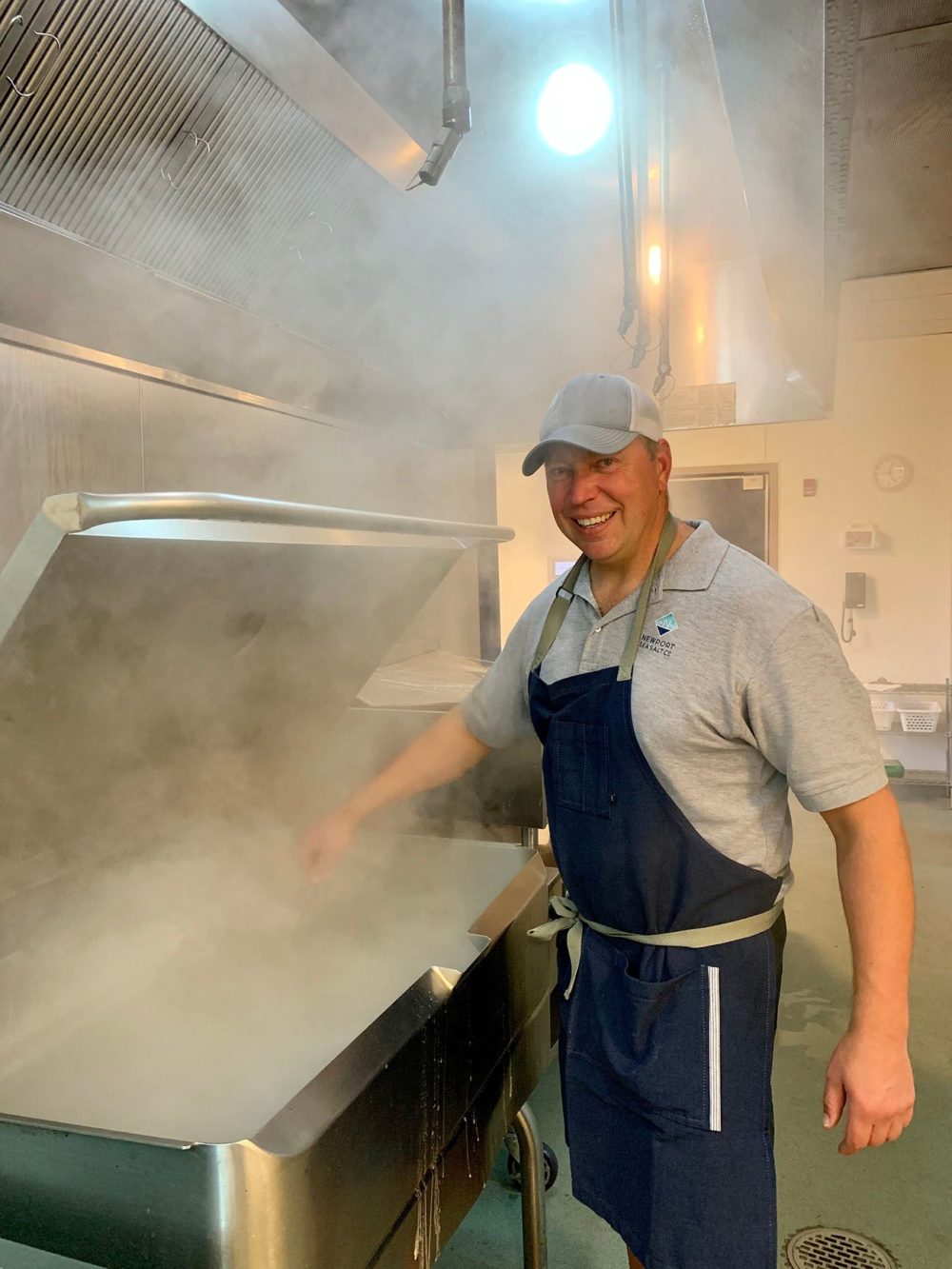Reviving the Ancient Craft of Salt Making
Local Hand-Harvested Sea Salt
By Meredith HaasMatt Mullins, co-owner of Newport Salt Co., collects seawater from Brenton Point.
We were out of salt. After months of home cooking during the COVID-19 pandemic, we went through basic supplies, like flour and yeast, much faster than previously—especially during the holidays. And whether you’re into baking or cooking, there’s no getting around the importance of salt. But instead of going to the store, my boyfriend and I thought it would be a good idea to try our hand at making our own. Plus, it was a sunny, clear, December day—a good excuse to get outside and go to the beach, armed with a 5-gallon bucket.
After filtering the seawater we had collected at East Matunuck, we filled a large Pyrex baking dish and set our oven set at 250˚F with the intent to evaporate all of the seawater and not burn the salt left behind. After many hours, we started to see white crystals form, becoming whiter and thicker as the water vapor escaped. The satisfying crunching sound as we scraped this beautiful, white, flaky salt into jars made us feel very accomplished—like modern-day Renaissance people.
And then we tried it.
Wow!
I had never tasted anything so bitter and salty. It was like salt on steroids, with a one-two punch that made my face cave in on itself.
How did this happen? Where did we go wrong?
“Oh, yeah, that’s those calcium and magnesium salts that come out of the solution first,” says Matt Mullins, co-owner of Newport Sea Salt Co. “They are super bitter … I filter those when I transfer the water from the boiling kettles to my simmering skillets.”
Noted.
Before he and his wife, Tami Mullins, started Newport Sea Salt Co. four years ago, their first batch, like ours, wasn’t very good. He and his oldest son had gone out to Brenton Point on a Sunday afternoon and filled half a bucket with seawater to bring home and make their first batch of sea salt.
“We were amazed that after a few hours the salt crystals started forming, but it wasn’t so successful,” he says, describing the same “bitter and very harsh, very in-your-face salty” experience.
“It was a series of trial and errors. Making salt is a mixture of art and science. You have to understand the different temperatures that will create different sizes of crystals and durations of boiling versus simmering.”
We have this great resource called the Atlantic Ocean, and nobody was utilizing it.
“FRESH INGREDIENTS, GOOD OLIVE OIL, AND GOOD SEA SALT.”
Matt and Tami Mullins started Newport Salt Co. when their supply of Mediterranean sea salt ran out, and they haven’t looked back.

Matt’s’ passion for sea salt grew from a career on the ocean. He spent 20 years in the Navy, traveling to over 40 countries. But it wasn’t until he was stationed in Naples, Italy, with his family on one of his last assignments before retirement, planning troop exercises in southern Europe and the Mediterranean, that he realized the power of salt.
“We really picked up on the proper use of seasoning [with] the Mediterranean sea salt—whether it’s seasoning fresh bruschetta or a big salad,” he explains.
The defining moment for them, they both recall, was trying the Fish of the Day at a small seaside restaurant on the Amalfi Coast.
“Until that point, we had pasta at every meal. Pasta, pasta, pasta,” laughs Tami.
“[The fish] was done so simply. It was fresh with just olive oil and sea salt, and grilled,” says Matt. “Mmmmmmm,” adds Tami, remembering their past meal.
“Eddie changed our life,” she says, referring to their Italian server who gave them sage advice that would be the seed of Newport Sea Salt Co.
“He said, ‘Fresh ingredients, good olive oil, and good sea salt is all you need.’”
Upon their return to the States, when the boxes of Mediterranean sea salt they carried home ran out, they were surprised that they could not find any local sources.
“I mean, considering here in Newport, we are an island literally surrounded by sea salt. And we are the Ocean State. We have this great resource called the Atlantic Ocean, and nobody was utilizing it. How can this be?” Matt says, recollecting his dismay.
“Salt is the most basic ingredient, yet [Rhode Island] was importing all our sea salt and it didn’t make sense. Imagine if Rhode Island was importing all of its quahogs? I like to say our quahogs taste so good because they’re marinating in our salt.”
Since perfecting their process, Newport Sea Salt Co. was born and now sells to 17 vendors, providing sea salt to restaurants, meat markets, olive oil shops, and local farmers markets, among others.
“Now, the process is much more refined and removes the bitterness, and instead of a salty punch to the face, it’s more palatable,” he says. “It enhances the flavor of the food.”
White Gold
Salt is one of the most omnipresent minerals on earth, found in inland deposits from ancient seas that have dried up or in the oceans where minerals are weathered from the land or released from the Earth’s interior at rifts in the seabed.
So much salt exists in the oceans that if it were all removed and spread over the surface of the Earth, it would form a layer about 500 feet thick, according to the National Oceanic and Atmospheric Administration. That’s the height of a 40-story office building!
Salt is the oldest food seasoning and preservative, a quality that helped propel modern globalization by allowing the transport of food over long trade routes or overseas journeys. Ancient cultures, such as the Egyptians, Greeks, Romans, Byzantines, and others, used salt in religious offerings and as a valuable currency that was traded pound for pound with gold.
Colonial Americans relied on salt imports from England or the Caribbean to preserve meat and fish in order to survive the harsh winters. During the Revolutionary War, salt shipments were blocked by the British, prompting the establishment of saltworks along the coasts for domestic salt making.
The last reference to a saltworks industry in Rhode Island seems to be in 1829 in Newport, according to the Newport Historical Society, although saltworks proliferated along the Cape Cod shoreline and elsewhere in New England late into the 19th century. But the coastal industry declined as inland sources became cheaper and easier to obtain and as the price of lumber needed to build saltworks rose. The advent of refrigeration to preserve food and other technological developments spelled the end of local saltworks.
“It’s been almost 200 years since anyone else has taken this sort of venture up of making salt here,” says Matt. “We are not the first ones to do this, but the first ones in a long time as we’re revitalizing an older craft of creating sea salt.”
Earning Your Salt
Originally, the Mullinses had planned on using a solar evaporation method—the oldest method of salt production that lets the sun do all the heavy lifting in evaporating water. This method is still highly popular around the world since it allows for larger batches to be made and is typically done in shallow ponds or artificial basins. But it works best in warmer climates.
“There’s no way to get rid of those bitter salts because everything you put in the pan and let the sun dry is all in the final product,” says Matt. But they went with the fire and stove method primarily because the Rhode Island Department of Health was not on board with solar evaporation. “My technique allows for a little more control, so I can eliminate those bitter salts … So, I’m glad DOH [the Department of Health] didn’t allow us to solar evaporate,” he says, because it led them to making a better product, “a more delicate flake that’s not so coarse or harsh.”

While the fire and stove method offers more control, it also makes an already physical process more physical. About once a week, depending on the weather, Matt heads out to Brenton Point with a 150-gallon tank to fill with seawater and transport back to Hope & Main in Warren, where they rent one of several commercial kitchens. He lets the seawater settle for a day or so and filters out seaweed and sand with fine-grade mesh filters so that the result looks like drinking water from a faucet.
“I really like collecting water during the winter months because generally we get these northern winds, creating calmer water and less turbidity and stuff to filter out,” he says.
Once filtered and ready, another day is spent boiling and simmering, transferring water from large kettles to simmering skillets. Matt arms himself with a timer and a chart that shows which salts come out of solution first to make sure he gets exactly the salt he wants.
“It takes one week to make a batch. It’s a physical process getting the salt, transferring it, and reducing it down. And then all the deliveries,” he says. “The batches are generally gone after a week. They’re sold before we even make them.”
One batch makes roughly 28 pounds of sea salt that carries a unique flavor of the region.
“Depending on where your source water is from, the trace minerals can change from location to location,” says Matt, adding that a local chef described their product as a “classic sea salt that was light on the palate” and not too high in any particular trace mineral “whereas some sea salts might be higher in iron, like Himalayan salt, which is why it’s pink.”
A Modern Upgrade
After hours of reducing seawater to sea salt, the final product is a mixture of large flakes and fine grains.
“Once the crystals start forming at the surface of the water, we let that settle to the bottom. It’s pretty neat looking—it looks like a piece of ice. When they get to a certain weight or density, they sink to the bottom of the pan. And that goes on for several hours. I’ll scoop that out, and it’s a nice, flaky, finishing-style salt, and then towards the end of the process, because there’s less salt in solution, the remaining salt is more fine, almost like a fleur de sel,” Matt explains. “We are able to capture that and use a lot of that finer salt for some of our mixtures and cocktail salts.”

While local chefs like using the larger flakes to finish dishes, Tami says that they often get feedback from customers who want a smaller-sized salt or different flavors.
“We never thought we would go down that lane. We wanted to stick to pure sea salt,” she says, adding that using that finer salt for their signature blends and cocktail salts has been successful.
“We do a butcher’s blend, which is great for seasoning burgers and steaks, but also scrambled eggs,” says Matt.
“Or Bloody Marys,” chimes in Tami.
“The rosemary thyme blend works great with fish and poultry,” Matt adds. “And a spicy one we make in collaboration with the Ocean State Pepper Company. He [Ocean State Pepper Company] grows the hot peppers here in Rhode Island, and we utilize them to make the spicy fire salt.”
Using local resources and collaborating with local businesses is a priority for the Mullinses and will shape how Newport Sea Salt Co. continues to evolve.
“We have such a supportive community … we’re just trying to figure out the next step,” says Tami, who continues to work part time at the Naval War College. “It’s our journey, and [our kids] are watching it all unfold. We’re very thankful.”
Their 16-year-old son, Matthew, says it’s been inspiring to have motivated and passionate parents dedicated to what they do. “It makes me want to achieve more in life and accomplish as much as they have. They also make some amazing meals with our sea salt!” he says.
“Who would’ve thought just plucking buckets of water would turn into a business,” adds Matt. “Somehow, we figured it out.”
Contact Us
Telephone: (401) 874-6805
Email: allard@uri.edu
Contributor Guidelines
Please review submission guidelines to be considered. d

